Top Rankings
Warwick School District ranks among the top 20% of public school district in Rhode Island for:
Category
Attribute
Community Size
Largest student body (number of students) (Top 1%)
For the 2025 school year, there are 2 public preschools serving 497 students in Warwick School District. This district's average pre testing ranking is 2/10, which is in the bottom 50% of public pre schools in Rhode Island.
Public Preschools in Warwick School District have an average math proficiency score of 12% (versus the Rhode Island public pre school average of 29%), and reading proficiency score of 12% (versus the 30% statewide average).
Minority enrollment is 37% of the student body (majority Hispanic), which is less than the Rhode Island public preschool average of 53% (majority Hispanic).
Overview
This School District
This State (RI)
# Schools
19 Schools
59 Schools
# Students
7,771 Students
19,920 Students
# Teachers
677 Teachers
1,495 Teachers
Student : Teacher Ratio
12:1
12:1
District Rank
Warwick School District, which is ranked within the top 50% of all 62 school districts in Rhode Island (based off of combined math and reading proficiency testing data) for the 2021-2022 school year.
The school district's graduation rate of 82% has decreased from 86% over five school years.
Overall District Rank
#32 out of 63 school districts
(Bottom 50%)
(Bottom 50%)
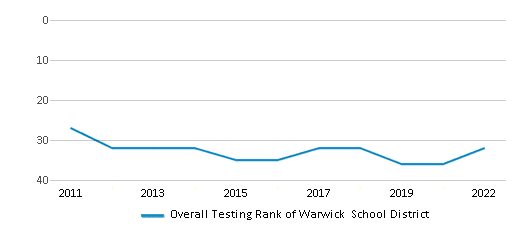
Math Test Scores (% Proficient)
22%
27%
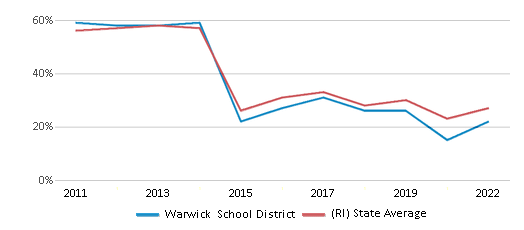
Reading/Language Arts Test Scores (% Proficient)
31%
33%

Science Test Scores (% Proficient)
29%
31%

Graduation Rate
82%
83%
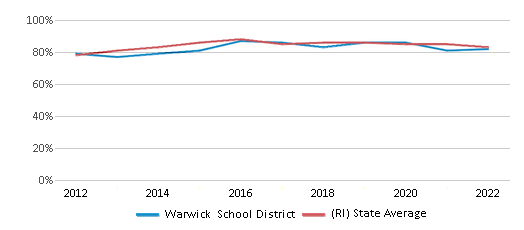
Students by Ethnicity:
Diversity Score
0.48
0.67
# American Indian Students
40 Students
156 Students
% American Indian Students
n/a
1%
# Asian Students
295 Students
571 Students
% Asian Students
4%
3%
# Hispanic Students
1,207 Students
6,341 Students
% Hispanic Students
16%
32%
# Black Students
240 Students
1,836 Students
% Black Students
3%
10%
# White Students
5,480 Students
9,320 Students
% White Students
71%
47%
# Hawaiian Students
9 Students
40 Students
% Hawaiian Students
n/a
1%
# Two or more races Students
500 Students
1,156 Students
% of Two or more races Students
6%
6%
Students by Grade:
# Students in PK Grade:
190
3,320
# Students in K Grade:
573
3,080
# Students in 1st Grade:
548
2,986
# Students in 2nd Grade:
582
2,902
# Students in 3rd Grade:
612
2,651
# Students in 4th Grade:
581
2,805
# Students in 5th Grade:
590
2,071
# Students in 6th Grade:
589
56
# Students in 7th Grade:
612
27
# Students in 8th Grade:
580
22
# Students in 9th Grade:
620
-
# Students in 10th Grade:
602
-
# Students in 11th Grade:
559
-
# Students in 12th Grade:
533
-
# Ungraded Students:
-
-
District Revenue and Spending
The revenue/student of $25,217 is higher than the state median of $22,250. The school district revenue/student has stayed relatively flat over four school years.
The school district's spending/student of $25,246 is higher than the state median of $21,467. The school district spending/student has stayed relatively flat over four school years.
Total Revenue
$196 MM
$2,998 MM
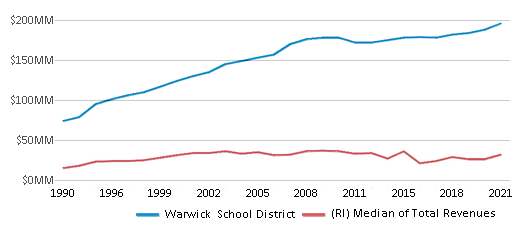
Spending
$196 MM
$2,892 MM

Revenue / Student
$25,217
$22,250
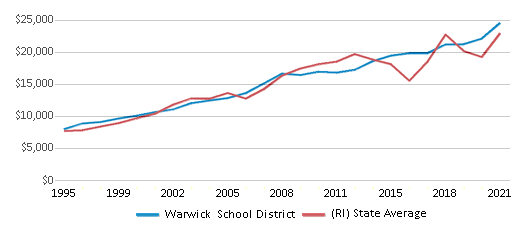
Spending / Student
$25,246
$21,467
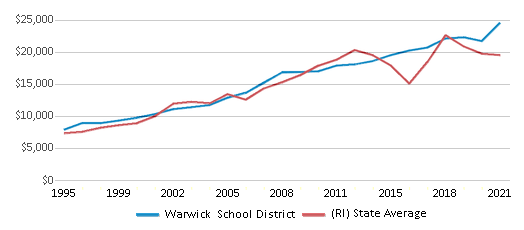
Best Warwick School District Public Preschools (2025)
School
(Math and Reading Proficiency)
(Math and Reading Proficiency)
Location
Grades
Students
Rank: #11.
Oakland Beach School
(Math: 10-14% | Reading: 10-14%)
Rank:
Rank:
2/
Bottom 50%10
383 Oakland Beach Avenue
Warwick, RI 02889
(401) 734-3420
Warwick, RI 02889
(401) 734-3420
Grades: PK-5
| 335 students
Rank: n/an/a
325 Miantonomo Drive
Warwick, RI 02888
(401) 734-3490
Warwick, RI 02888
(401) 734-3490
Grades: PK
| 162 students
Recent Articles

Year-Round Or Traditional Schedule?
Which is more appropriate for your child? A year-round attendance schedule or traditional schedule? We look at the pros and cons.

Why You Should Encourage Your Child to Join a Sports Team
Participating in team sports has a great many benefits for children, there is no doubt. In this article you will learn what those benefits are.

White Students are Now the Minority in U.S. Public Schools
Increasing birth rates among immigrant families from Asia and Central and South America, combined with lower birth rates among white families, means that for the first time in history, public school students in the United States are majority-minority. This shift in demographics poses difficulties for schools as they work to accommodate children of varying language abilities and socio-economic backgrounds.





